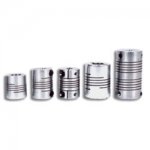MULTUSB200
Plastic
- Joined
- Feb 13, 2016
hello friends,
I need to machine a 3 start 0.012" wide spiral on a ss beam coupling.
(OD of coupling is 5/8" and ID is roughly 3/16")
I am wondering how are these spirals on couplings machined?
they are usually very thin, and using a slitting saw may present problems as the spiral will
force the saw to bend around it thus breaking the saw or widening the spiral slot.
Is wire edm better suited for this operation?
If so - is it possible to cut such a spiral without supporting the wire on
the opposite end?
what I mean is piercing the coupling mid way and starting a ( 3 start) spiral? basically using the wire to erode material as if it was a "0.015" end mill? simultaneously turning the rotary axis around the axis if the coupler and advancing longitudinally to achieve the spiral?

I need to machine a 3 start 0.012" wide spiral on a ss beam coupling.
(OD of coupling is 5/8" and ID is roughly 3/16")
I am wondering how are these spirals on couplings machined?
they are usually very thin, and using a slitting saw may present problems as the spiral will
force the saw to bend around it thus breaking the saw or widening the spiral slot.
Is wire edm better suited for this operation?
If so - is it possible to cut such a spiral without supporting the wire on
the opposite end?
what I mean is piercing the coupling mid way and starting a ( 3 start) spiral? basically using the wire to erode material as if it was a "0.015" end mill? simultaneously turning the rotary axis around the axis if the coupler and advancing longitudinally to achieve the spiral?



 !
!